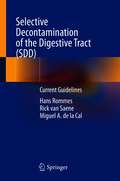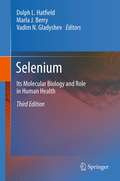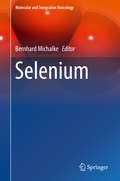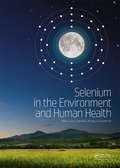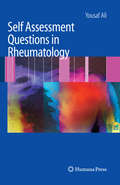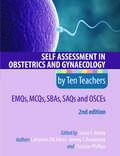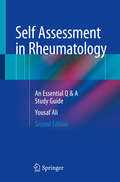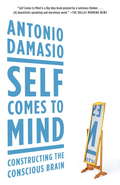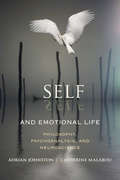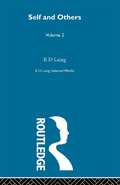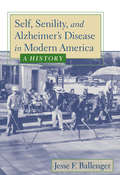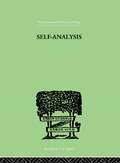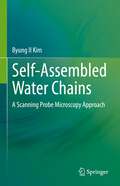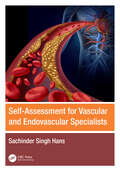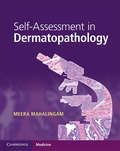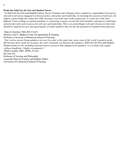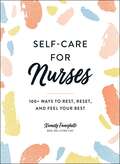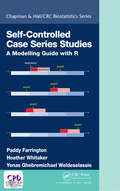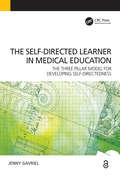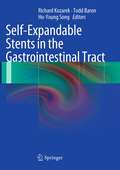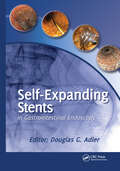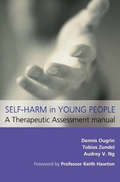- Table View
- List View
Selective Decontamination of the Digestive Tract (SDD): Current Guidelines
by Hans Rommes Rick van Saene Miguel A. de la CalThis book explains the basic concepts of Selective Decontamination of the Digestive tract (SDD) to help those involved in treating critically ill patients to improve outcomes and the quality of care. SDD has led to major changes in our understanding, the treatment and prevention of infections in critically ill patients over the past 40 years. It is the most studied intervention in intensive care medicine and is the subject of 73 randomized controlled trials, including over 15000 patients and 15 meta-analyses. SDD reduces morbidity and mortality, is cost-effective and safe as SDD does not increase antimicrobial resistance. Correct application of the SDD strategy enables ICU teams to control infections – even in ICUs with endemic antibiotic resistant microorganisms such as methicillin resistant S. aureus (MRSA). Describing the concept and application of SDD, and presenting case studies and microbiological flow charts, this practical guide will appeal to intensivists, critical care practitioners, junior doctors, microbiologists and ICU-nurses as well as infection control specialists and pharmacists.
Selenium
by Dolph L. Hatfield Vadim N. Gladyshev Marla J. BerryMany health benefits have been attributed to selenium that include preventing various forms of cancer (e.g., colon cancer, prostate cancer, lung cancer and liver cancer), heart disease and other cardiovascular and muscle disorders, inhibiting viral expression, delaying the progression of acquired immunodeficiency syndrome (AIDS) in human immunodeficiency virus (HIV)-positive patients, slowing the aging process, and having roles in mammalian development, including male reproduction and immune function. The purpose of the book is the same as the first two volumes which is to bring an up to date status of current research in the rapidly developing selenium field centered around the health benefits attributed to this element and how this element makes its way into protein.
Selenium (Molecular and Integrative Toxicology)
by Bernhard MichalkeThis book summarizes the fast-growing and current knowledge about selenium interaction with cancer, diabetes, neuro-degeneration, heart disease, muscle disorders, HIV and several more. A special focus will be placed on in-depth knowledge about gene expression, selenoprotein biosynthesis, seleno-metabolism--as well as the molecular pathways, physiological roles, and the molecular action of selenium including interaction with other elements and vitamins or as Se-nanoparticles. The reader will receive the newest information regarding redox status and redox regulatory systems, specifically in relation to different glutathione peroxidases and thioredoxin-reductases as well as about cellular bioavailability and cytotoxicity, de-balanced immune response, inflammation or dietary aspects.
Selenium in the Environment and Human Health
by Xuebin Yin G. S. Bañuelos Z. Q. LinSelenium is arguably the naturally occurring trace element of greatest concern worldwide. In excessive amounts it can lead to toxicosis and teratogenesis in animals, while the impact of selenium deficiency can be even more significant. Contributors from 22 countries explored the connections and inter-relationships between selenium in the environmen
Self Assessment Questions in Rheumatology
by Yousaf AliThis book illustrates, in a succinct question and answer format, a variety of different scenarios of rheumatic disease. In its discussion of common and uncommon cases, the book presents the seasoned experiences of a leading rheumatologist. These questions and cases are easily translated into everyday practice and might well be presented during ward rounds, in clinic, or during boards. The book is an excellent resource for postgraduate fellows, internists and students who are eager to learn more about rheumatology, test their fund of knowledge, or prepare for board examinations.
Self Assessment in Obstetrics and Gynaecology by Ten Teachers 2E EMQs, MCQs, SBAs, SAQs & OSCEs
by Catherine Aiken Jeremy Brockelsby Christian PhillipsThis book presents medical students and those preparing for postgraduate examinations with an ideal opportunity to assess their levels of knowledge and understanding in obstetrics and gynaecology, and to practice their exam technique across a range of question formats. It can be used as a standalone revision guide, but is also designed to complemen
Self Assessment in Rheumatology: An Essential Q & A Study Guide
by Yousaf AliThis practical study guide illustrates a variety of different scenarios of rheumatic disease in succinct question and answer format. It contains 120 complex cases with potentially unusual diagnoses designed to stimulate thought and further reading in this rapidly evolving specialty. The questions demonstrate both common and uncommon rheumatologic conditions that may be encountered on ward rounds or in clinic by using radiographs, pictures, and skin findings. Each case is based on a real-life diagnostic situation encountered by the author from his two decades of experience working in a busy consultative practice.Self Assessment in Rheumatology: An Essential Q & A Study Guide, Second Edition is an essential resource for students, postgraduate fellows, internists, and practicing physicians eager to learn more about rheumatology, test their fund of knowledge, or prepare for board examinations.
Self Comes to Mind: Constructing the Conscious Brain
by Antonio DamasioOne of the most important and original neuroscientists at work today tackles a question that has confounded neurologists, philosophers, cognitive scientists, and psychologists for centuries: how consciousness is created.
Self and Emotional Life: Philosophy, Psychoanalysis, and Neuroscience (Insurrections: Critical Studies in Religion, Politics, and Culture)
by Catherine Malabou Adrian JohnstonAdrian Johnston and Catherine Malabou defy theoretical humanities' deeply-entrenched resistance to engagements with the life sciences. Rather than treat biology and its branches as hopelessly reductive and politically suspect, they view recent advances in neurobiology and its adjacent scientific fields as providing crucial catalysts to a radical rethinking of subjectivity.Merging three distinct disciplines—European philosophy from Descartes to the present, Freudian-Lacanian psychoanalysis, and affective neuroscience—Johnston and Malabou triangulate the emotional life of affective subjects as conceptualized in philosophy and psychoanalysis with neuroscience. Their experiments yield different outcomes. Johnston finds psychoanalysis and neurobiology have the potential to enrich each other, though affective neuroscience demands a reconsideration of whether affects can be unconscious. Investigating this vexed issue has profound implications for theoretical and practical analysis, as well as philosophical understandings of the emotions.Malabou believes scientific explorations of the brain seriously problematize established notions of affective subjectivity in Continental philosophy and Freudian-Lacanian analysis. She confronts philosophy and psychoanalysis with something neither field has seriously considered: the concept of wonder and the cold, disturbing visage of those who have been affected by disease or injury, such that they are no longer affected emotionally. At stake in this exchange are some of philosophy's most important claims concerning the relationship between the subjective mind and the objective body, the structures and dynamics of the unconscious dimensions of mental life, the role emotion plays in making us human, and the functional differences between philosophy and science.
Self and Others: Selected Works Of R D Laing Vol 2 (Selected Works of R D Laing)
by R D LaingOriginally published in 1961 this book is divided into two parts. In the first Laing critiques the Kleinian view of unconsciou phantasy, as developed by Susan Sutherland Isaacs. He emphasizes the overwhelming presence of social phantasy systems. In Part 2, Laing discusses the extent to which an individual is or is not invested in their own actions, using ideas drawn from Martin Buber and Sartre
Self, Culture and Consciousness: Interdisciplinary Convergences On Knowing And Being
by Sangeetha Menon V. V. Binoy Nithin NagarajThis volume brings together the primary challenges for 21st century cognitive sciences and cultural neuroscience in responding to the nature of human identity, self, and evolution of life itself. Through chapters devoted to intricate but focused models, empirical findings, theories, and experiential data, the contributors reflect upon the most exciting possibilities, and debate upon the fundamental aspects of consciousness and self in the context of cultural, philosophical, and multidisciplinary divergences and convergences. Such an understanding and the ensuing insights lie in the cusp of philosophy, neurosciences, psychiatry, and medical humanities. In this volume, the editors and contributors explore the foundations of human thinking and being and discuss both evolutionary/cultural embeddedness, and the self-orientation, of consciousness, keeping in mind questions that bring in the interdisciplinary complexity of issues such as the emergence of consciousness, relation between healing and agency, models of altered self, how cognition impacts the social self, experiential primacy as the hallmark of consciousness, and alternate epistemologies to understand these interdisciplinary puzzles.
Self, Senility, and Alzheimer's Disease in Modern America: A History
by Jesse F. BallengerHistorian Jesse F. Ballenger traces the emergence of senility as a cultural category from the late nineteenth century to the 1980s, a period in which Alzheimer's disease became increasingly associated with the terrifying prospect of losing one's self. Changes in American society and culture have complicated the notion of selfhood, Ballenger finds. No longer an ascribed status, selfhood must be carefully and willfully constructed. Thus, losing one's ability to sustain a coherent self-narrative is considered one of life's most dreadful losses. As Ballenger writes "senility haunts the landscape of the self-made man." Stereotypes of senility and Alzheimer's disease are related to anxiety about the coherence, stability, and agency of the self—stereotypes that are transforming perceptions of old age in modern America. Drawing on scientific, clinical, policy, and popular discourses on aging and dementia, Ballenger explores early twentieth-century concepts of aging and the emergence of gerontology to understand and distinguish normal aging from disease. In addition, he examines American psychiatry's approaches to the treatment of senility and scientific attempts to understand the brain pathology of dementia.Ballenger's work contributes to our understanding of the emergence and significance of dementia as a major health issue.
Self-Analysis
by Horney, KarenFirst Published in 1999. Routledge is an imprint of Taylor & Francis, an informa company.
Self-Assembled Water Chains: A Scanning Probe Microscopy Approach
by Byung Il KimDespite advances in the long-range electrostatic double-layer force, which depends strongly on ionic strength in water by using theoretical models such as DLVO (Derjaguin, Landau, Verwey, and Overbeek), the structure of confined water in air still remains widely unknown and has led to a variety of unexplained phenomena. This book bridges that gap by introducing a newly developed scanning probe miscroscopy (SPM) approach, which enables one to probe confined water at the molecular and atomic scale. Written by the developer of SPM, this book covers this new approach, as well as original approaches to addressing general interfacial water issues. It also introduces the cantilever-based optical interfacial force microscope (COIFM), which was invented by the author along with the methodology. The improved understanding will contribute to liquid-based nano- and bio-technologies such as lab-on-a-chip technologies, nanofluidic devices, dip-pen nanolithography, nano-oxidation, water-based granular interactions, liquid-based nanolubricants, hydration layers in biopolymers, manipulation of biomolecules, protein folding, stability of colloid suspensions, enzyme activity, swelling in clays, development of bioactive surfaces, water columns and ion channeling in membranes and scanning probe microscopy (SPM). It will also contribute to the improved performance of moving components in silicon-based micro-electro-mechanical system (MEMS) devices, where water plays a key role in interfacial interactions.
Self-Assessment In Accident and Emergency Medicine
by Derek Burke Ian Greaves Philip HormbreyA pocket-sized self-test book designed for junior doctors. It features not only multiple choice questions, but also case histories, questions on ECGs, data interpretation, x-ray and picture questions. The range of subjects covered is comprehensive andthe answers informative and unambiguous.Designed for junior doctors, Self Assessment in Accident and Emergency Medicine features not only MCQs but also case histories, questions on ECGs, data interpretation, X-ray and picture questions. The range of subjects covered is comprehensive, coveringall the common problems encountered in the Accident and Emergency Department. Also included are the rarer conditions which many inexperienced doctors find difficult to diagnose. This entertaining and informative guide provides a convenient way ofaquiring information and testing knowledge for all doctors working in A&E. It will also become an indispensible study aid for candidates for the Accident and Emergency Fellowship and the Accident and Emergency Faculty exams.
Self-Assessment for Vascular and Endovascular Specialists
by Sachinder Singh HansIncluding over 500 multiple choice questions covering a wide range of vascular disorders to test the skills of all vascular specialists. Suitable for postgraduate trainee vascular medicine internists, interventional radiologists, vascular surgeons, and endovascular therapists as they prepare for exams or ensure that they remain up to date. Divided into 21 subject specific-sections and meticulously written and researched, the questions and their accompanying rationales are enhanced by explanatory illustrations and supported by key references. Students and experienced clinicians will be prepared for both testing and teaching in all aspects of clinical practice. Advances in the treatment of vascular disease have played a significant role in rising life expectancy over the past 70 years, resulting in lower morbidity, mortality, and quicker recoveries. However, there remains an urgent challenge in controlling risk factors such as obesity, sedentary lifestyles, and tobacco abuse. As explosive growth in endovascular technology continues, it is more important than ever for vascular specialists to remain proficient and stay up to date.
Self-Assessment in Dermatopathology
by Meera MahalingamAn essential examination resource for anyone sitting their primary or maintenance of certification examinations in dermatology, pathology or dermatopathology, Self-Assessment in Dermatopathology uses histopathology as a catalyst for constructive and critical thinking and to trigger relevant clinical, genetic and syndromic associations. Concise explanations at the end of each chapter give short answers to each question and expand on each answer choice. Each chapter consists of an increasingly difficult selection of questions, allowing the reader to develop and self-test their knowledge. Tables relevant to the section covered have also been incorporated in the answer section. Using this practical approach, the reader will become familiar with the pathologic basis of clinically relevant dermatoses and cutaneous tumors. The question and answer format make this book the first resource of its kind. Thinking about information in a new way is the foundation of this book, making it an invaluable addition for any trainee.
Self-Care for New and Student Nurses
by Dorrie Fontaine Tim Cunningham Natalie MayWhile you have chosen one of the most noble professions, you have also chosen one of the most difficult. In your career, you will face challenges big and small, whether it is a problematic coworker, the death of a favorite patient, or a global pandemic. You will have bad days or weeks when you ask yourself why you didn't choose a less demanding path in life. You will experience exhaustion, frustration, and grief. You will balance not only your nursing responsibilities, but also your commitments to your family and community. But as you question your life choices and wonder how you can take one more step forward, that voice inside you will whisper, "You are a nurse." <p><p>Our goal in writing this book is that you never have to betray that voice. No matter what comes your way, you will have the strength, skills, and resilience to keep moving forward. But let us be clear: we do not want you to move forward at the expense of yourself or your well-being. We want you to move forward with wisdom and clarity of purpose by using every resource you can muster. We hope that what is contained in this book will become a valuable resource throughout the early years of your career, and even beyond. <p><p>We welcome you on this journey, and we hope you welcome the opportunity to explore the concept of self-care, what it means, what works best for you, and how it can help you flourish in good times and help you grow in difficult ones.
Self-Care for Nurses: 100+ Ways to Rest, Reset, and Feel Your Best
by Xiomely FamighettiTake care of your patients by taking care of yourself with these 100 self-care activities specifically designed to help nurses reduce stress, feel their best—and ready to make a difference!There&’s no doubt about it: today&’s healthcare workers have a lot on their plates. Between balancing the needs of your patients and giving your all to support your coworkers, getting burnt out and overwhelmed is a real risk. So how do you make sure you take time for yourself to recharge? With Self-Care for Nurses, you&’ll find 100 activities specifically designed to help you relax, take a break, and feel reenergized. Whether you need a quick pick-me-up in the middle of your shift or are looking for some new ways to unwind after the workday is over, you&’ll find helpful solutions like: -Writing a list of your accomplishments -Practicing yoga -Learning how to ask for help -And much more! Whether you&’re a new nurse or a seasoned veteran, self-care is important for all. Start your nursing self-care practice—today!
Self-Controlled Case Series Studies: A Modelling Guide with R (Chapman & Hall/CRC Biostatistics Series)
by Paddy Farrington Heather Whitaker Yonas Ghebremichael WeldeselassieSelf-Controlled Case Series Studies: A Modelling Guide with R provides the first comprehensive account of the self-controlled case series (SCCS) method, a statistical technique for investigating associations between outcome events and time-varying exposures. The method only requires information from individuals who have experienced the event of interest, and automatically controls for multiplicative time-invariant confounders, even when these are unmeasured or unknown. It is increasingly being used in epidemiology, most frequently to study the safety of vaccines and pharmaceutical drugs. Key features of the book include: A thorough yet accessible description of the SCCS method, with mathematical details provided in separate starred sections. Comprehensive discussion of assumptions and how they may be verified. A detailed account of different SCCS models, extensions of the SCCS method, and the design of SCCS studies. Extensive practical illustrations and worked examples from epidemiology. Full computer code from the associated R package SCCS, which includes all the data sets used in the book. The book is aimed at a broad range of readers, including epidemiologists and medical statisticians who wish to use the SCCS method, and also researchers with an interest in statistical methodology. The three authors have been closely involved with the inception, development, popularisation and programming of the SCCS method.
Self-Directed Learner - the Three Pillar Model of Self-Directedness: The Three Pillar Model for Developing Self-Directedness
by Jennifer GavrielSelf-directed learning is perhaps the Holy Grail of adult learning and for good reason. Within this seemingly simple phrase lies the battleground for the frustrations of both educator and learner as they work through the difficulties of an unequal and sometimes intense partnership
Self-Expandable Stents in the Gastrointestinal Tract
by Ho-Young Song Richard Kozarek Todd BaronSelf-expandable stents were initially placed for the treatment of cardiovascular diseases but now play an integral role in the relief of benign and malignant obstruction of the gastrointestinal tract and biliary system. Self-Expandable Stents in the Gastrointestinal Tract will familiarize the reader with the indications, techniques, and outcome following placement of expandable metal stents within the gastrointestinal tract. The volume covers all aspects of expandable stents including their composition, tissue responses, and placement techniques. In addition, placement using endoscopic and radiologic techniques is discussed. Unique illustrations allow the reader to gain knowledge that will improve their ability to care for their patients. The volume will serve as a comprehensive reference for all aspects of expandable stents. Self-Expandable Stents in the Gastrointestinal Tract will be extremely useful for physicians in the field of gastroenterology, endoscopy, and radiology, as well as gastrointestinal and thoracic surgeons whether they are in training or practice.
Self-Expanding Stents in Gastrointestinal Endoscopy
by Douglas AdlerThere is a tremendous interest in information on stents in the world of gastrointestinal endoscopy. Many physicians did not train in an era where these stents were available, but are now being called upon to place them. Self-Expanding Stents in Gastrointestinal Endoscopy looks to provide physicians with the necessary and unique all-in-one resource on stents. Self-Expanding Stents in Gastrointestinal Endoscopy by Dr. Douglas G. Adler covers the use of self-expanding stents. This book will cover the use of all available devices in all clinical contexts, with step-by-step instructions from experts in the field on how to use them and, just as importantly, what not to do when using these devices. Self-Expanding Stents in Gastrointestinal Endoscopy is illustrated with more than 150 color photographs, as well as many tables and diagrams.Benefits and Features:· Soup-to-nuts format covers the use of all devices available on the market in all clinical situations· All chapters authored by recognized experts in the world of stents who have independently published extensive research in gastrointestinal endoscopy· Over 150 color photographs to guide readers from start to finish through all steps of learning about the proceduresSelf-Expanding Stents in Gastrointestinal Endoscopy brings attention to the use of self-expanding stents in benign and malignant diseases, the avoidance and management of complications, and the future of these devices.Self-Expanding Stents in Gastrointestinal Endoscopy is the perfect go-to book for all practicing gastroenterologists, fellows, and general and colorectal surgeons.
Self-Harm in Young People: A Therapeutic Assessment Manual
by Dennis Ougrin Tobias Zundel Audrey V NgSelf-harm is a distressing and all too common presentation to emergency departments, and yet there is no clear understanding of what it represents, and success rates of interventions to prevent future episodes are enormously variable.Therapeutic Assessment for self-harm is a pragmatic model, developed by the authors of this book and forming an orga
Self-Healing With Reiki: How to create wholeness, harmony and balance for body, mind and spirit
by Penelope QuestMost people attending a Reiki workshop are taught the basics of self-treatment with Reiki, but few discover Reiki's real potential for self-healing. It is an amazing tool for healing mind, body, emotions and spirit to create wholeness and harmony, personal peace and a sense of purpose. This book is packed with innovative yet easy-to-use techniques and is aimed at everyone who has worked with Reiki at any level. This book includes: New ways of using Reiki to heal the whole person, from the subtle energies of the aura to the physical body, for a healthier and more balanced life; a 'whole life' approach to self-healing, including psychological, emotional, social and environmental issues; unique methods of using Reiki more creatively for spiritual development and self-understanding; techniques from both Eastern and Western Reiki traditions; exclusive special meditations; easy-to-follow diagrams; accessible text, and clear explanations and examples.
